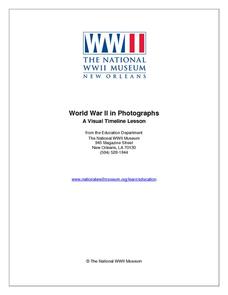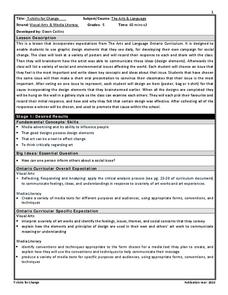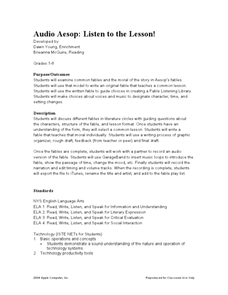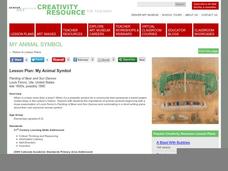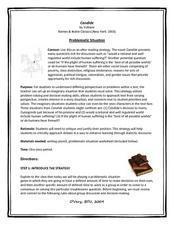National WWII Museum
World War II in Photographs
A picture is worth a thousand words, and this activity is worth so much more! Learners closely analyze a series of photographs from World War II, matching them with their appropriate captions and sequencing them into a correct timeline.
Conneticut Department of Education
Instructional Strategies That Facilitate Learning Across Content Areas
Imagine 28 instructional strategies, appropriate for all subject areas and all grade levels. Directed Reading-Thinking Activities (DRTA), Question-Answer Relationship (QAR) activities, KWL charts, comparison matrixes, classification...
Developing a Global Perspective for Educators
Imagine Being Me
The design of this two-day activity eloquently exposes learners to the topic of social justice for people with disabilities. The plan is built off the reading of Are You Alone on Purpose? by Nancy Werlin. The activity introduces readers...
Curated OER
Say Hi to Haibun Fun
Students examine the Japanese writing form of Haibun. They identify the elements of Japanese prose and poetry, analyze a haibun for writing devices, complete a graphic organizer, and compose an original haibun as a form of journal keeping.
Curated OER
Understanding and Fighting Stereotypes through Words and Images
Use some provocative modern art to get your class considering stereotypes and the impact they have on us all. Your class will discuss the print art Indian Look-Alike by Melanie Yazzie and stereotypes in general before conducting research...
Curated OER
The Times and Life During the California Gold Rush
Fourth graders read about the era in their history books, write in their journals revolving around the Gold Rush, making crafts such as newspapers, and also play the part of the Forty-niners.
Curated OER
Crane, London, and Literary Naturalism
Students analyze "To Build a Fire" by Jack London and "The Open boat" by Stephen Crane. They write an essay in which they compare and contrast the narrators and plots in each story.
Curated OER
T-shirts for Change
Can school children change the world? With a social or environmental issue in mind, 5th graders use what they know about advertising media to make t-shirts that have something to say. They research the issue they'd like to focus on,...
Curated OER
Audio Aesop: Listen to the Lesson!
Aesop's Fables are the focus of this language arts lesson. Young philosophers study and discuss the morals found in the most famous of Aesop's Fables. They write an original fable that teaches a common moral. A "Fable Listening Library"...
Social Media Toolbox
Verification
When you're putting together a great story, you've got to consider the source! Scholars discover the dangers of errors in reporting during the 14th activity in a 16-part Social Media Toolbox series. Groups collaborate to create a source...
Denver Art Museum
My Animal Symbol
Here is an art lesson plan that combines visual arts and language arts into one very nice package. In it, youngsters study a fascinating painting called Painting of Bear and Sun Dances. They begin to understand the importance of...
Curated OER
Candide: Problematic Situation
"Would a rational and well-regulated world include human suffering?" "If the plight of human suffering is the 'best of all possible worlds' do humans have freewill?" Class members develop their position on an issue raised by Candide,...
National Gallery of Canada
Who Are You?
What can a self-portrait reveal about an artist? Discuss various self-portraits before tasking your pupils with creating their own. Learners research artists, develop an idea of their own individuality, and create photo collages with...
Curated OER
African American Women Before and After the Civil War: Slavery and Freedom
Students listen to data on African American women in Texas before the Civil War. In this Civil War lesson, students compare and contrast the lives of slave and free women, and discuss case studies, locating areas on a map. Students...
Generation Rx
My Generation Rx: Plot Twists
How can prescription drugs be dangerous if they were prescribed by a doctor? Is it okay to share your prescription drugs with friends if they really need them? Clear up any common misconceptions about prescription drugs with a set of...
K12 Reader
National Symbols
What are the most prominent symbols of the United States? Learn about the bald eagle, the American flag, and the Statue of Liberty in a reading comprehension activity that includes a short passage and five reflective questions.
Curated OER
Barnyard Protest: Cows, Chickens & Fundamental Freedoms
Here is an ambitious and engaging lesson that should help elementary schoolers begin to develop a basic understanding of human rights. Pupils are asked to think about their own rights, the rights of others, and how an individual's voice...
Curated OER
The Kidlink Day Project
Students create journal entries on-line as part of a "Kidlink Day" activity. Entries are compared and evaluated by their peers. The writing process is practiced in this lesson.
Curated OER
History of American Child Labor
Students study the historical and social issue of child labor. They examine the photographs of Lewis Hine to see evidence of child labor and decide how the photographs depict the historical impact of the practice. They write a letter to...
Curated OER
What is Your Issue?
Students discuss and debate critical political and social issues facing the United States today.
Curated OER
Getting Around - Transportation Photographs
Students locate historical photographs of different types of transportation on a given website. They choose three to analyze and write about. If there is no information with the photo, students will need to research their chosen types of...
Curated OER
The Functions of Crime and Deviance
In this Functions of Crime worksheet, students respond to various writing prompts including examining theories and theorists and explaining key concepts.
Curated OER
Harriet Tubman: Recognizing the Human Agency
Tenth graders examine the contributions of Harriet Tubman to the history of Canada. They read a handout, complete a handout in small groups, and write a speech evaluating how Harriet Tubman changed history.
Curated OER
The Atomic Bomb Dilemma
Students examine consequences of using atomic bomb in light of resulting peace, distinguish between fact and opinion and analyze sources to recognize bias and points of view, and assume role of reporter, critic, cabinet member, or...


